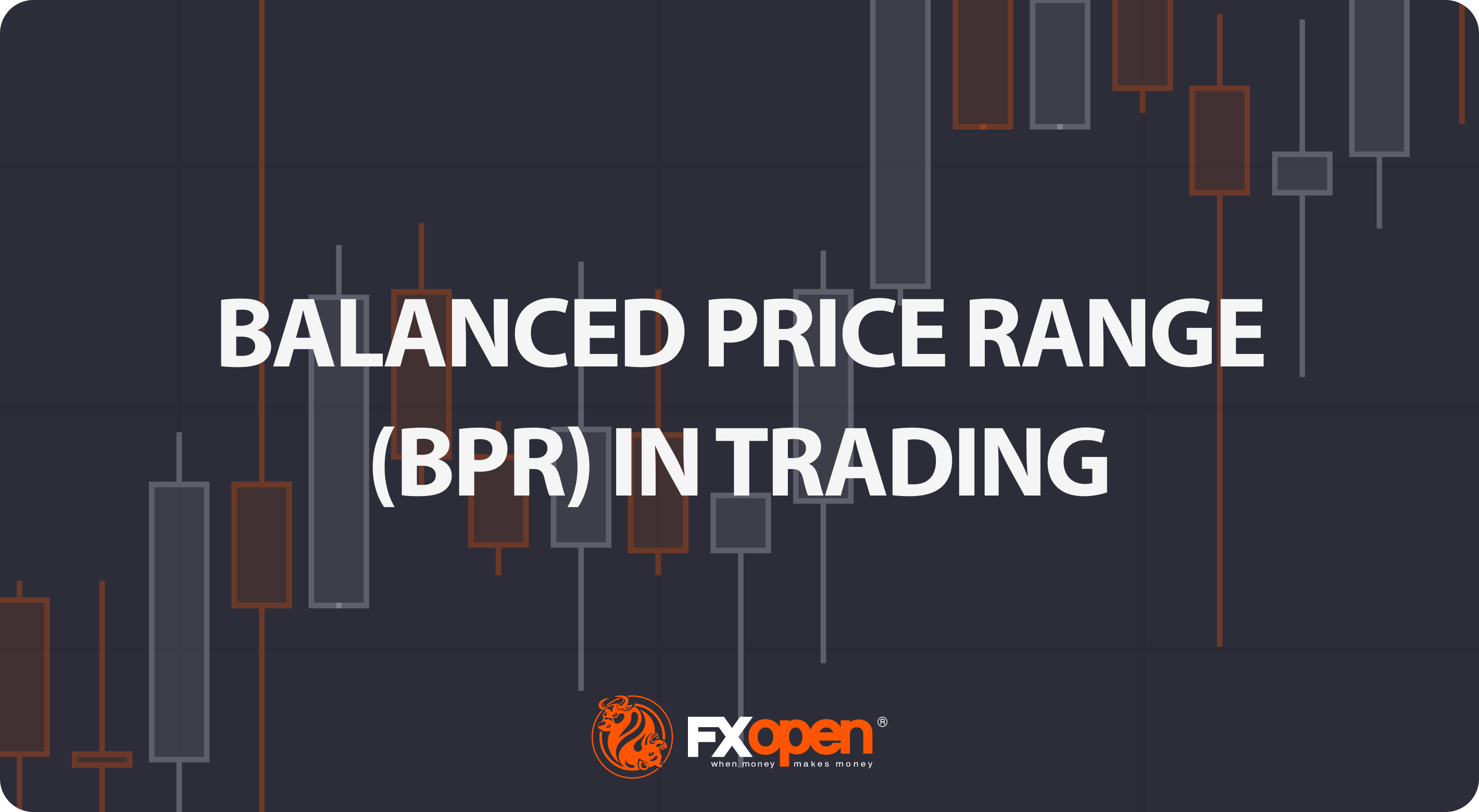What Is a Balanced Price Range and How To Use It in Trading?

Balanced Price Ranges (BPRs) offer traders insight into areas where market forces temporarily balance. Understanding how BPRs form and how to use them can help traders identify key zones of interest on the chart. This article explores the details of BPRs, their applications in trading, and how combining them with other tools can refine your market analysis.
What Is a Balanced Price Range (BPR)?
A Balanced Price Range (BPR) is an Inner Circle Trader (ICT) concept used to pinpoint areas on a price chart where market activity reflects a temporary equilibrium between buyers and sellers. These zones, often identified through overlapping Fair Value Gaps (FVGs), highlight price levels where buying and selling pressures have offset each other, creating a balance.
Heres how it works in a bullish scenario: a rapid price move downward leaves a bearish Fair Value Gapa price range the market skips over due to strong selling momentum. If the price rises with equal intensity shortly, creating a bullish Fair Value Gap in the opposite direction, the overlapping region between these gaps becomes the BPR. This overlap represents a zone of temporary balance, where the market has effectively corrected the earlier imbalance.
BPR zones are not random. They often form in areas of high market interestperhaps near key support or resistance levels, or after significant news events that cause sharp price movements. Traders look at these ranges because they frequently act as reference points for future price reactions.
The boundaries of an ICT BPRits high and lowserve as critical levels. These edges often function as dynamic support and resistance, helping traders gauge potential turning points. Furthermore, BPRs can appear across various timeframes, from minute-by-minute to weekly charts.
How Does a Balanced Price Range Form?
Now that we know the idea of the ICT Balanced Price Range, lets look at how it forms step by step.
1. An Initial Price Imbalance
A BPR begins with a strong price movement in one directioneither up or down. For example, in an overall bearish scenario, buyers initially drive the price up rapidly and leave behind a bullish FVG. This gap reflects an area where the market didnt fully engage, often skipping over price levels due to overwhelming demand.
2. A Counter-Move Creates an Opposing Gap
After the initial move, the market can shift in the opposite direction with equal momentum. In our example, sellers step in, pushing the price downward. This creates a bearish FVG that partially overlaps with the earlier bullish FVG. These rapid shifts often occur around key events, such as news releases or liquidity grabs, which ignite temporary market imbalances.
3. Overlapping Fair Value Gaps Define the Range
The overlapping portion of the bullish and bearish FVGs is what forms the BPR. This zone represents the price levels where buying and selling forces are temporarily balanced, neutralising the earlier imbalances.
4. Market Consolidation and Testing
Once the BPR is established, the price often consolidates near this range. This zone acts as a magnet for future price action because its seen as an area of high market interest, where traders may take note of previous balance. In the example given, a test may precede a bearish reaction.
Combining BPRs With Other ICT Concepts
Balanced Price Ranges in the ICT methodology become even more powerful when combined with other related concepts. By layering multiple tools, traders can refine their analysis and pinpoint high-probability areas for market activity. Heres how BPRs work with key ICT concepts:
Fair Value Gaps
Since BPRs are defined by overlapping fair value gaps, understanding how to read these gaps adds depth to BPR analysis. FVGs outside the BPR can act as supplementary zones of interest.
Order Blocks
Traders often spot BPRs forming near significant order blocks. When these zones overlap, they highlight areas where institutional activity may have left a footprint, increasing their importance for analysis.
Liquidity Pools
BPRs often align with liquidity zones where stop orders are clustered. Price may gravitate toward these areas before reacting, offering traders insight into potential price reversals or continuations.
Market Structure Shifts
BPRs can reinforce insights gained from market structure shifts. For example, a BPR forming after a break in structure might signal consolidation before the next major move.
Higher Timeframe Confluence
When a BPR aligns with key levels on higher timeframes, it can provide added confidence in the zones relevance for price reactions.
How to Use a Balanced Price Range
The Balanced Price Range can provide traders with valuable insights into price behaviour, acting as a reference point for analysing potential market movements. By understanding how these zones function, traders often use them to refine their strategies and enhance their market analysis.
Identifying High-Interest Zones
As BPRs highlight areas where the market found an equilibrium between buyers and sellers, traders typically monitor how the price reacts when revisiting a BPR. For example, if the price approaches the upper or lower boundary of a BPR, it may indicate a potential turning point or a continuation, depending on the market context.
Support and Resistance Dynamics
One common approach is to view BPRs as dynamic support or resistance zones. When the price tests the range, traders often anticipate a reaction. For instance, a rejection from a BPR in a bearish trend may suggest continued downward momentum, while a breach might signal weakening selling pressure.
Contextualising Larger Market Structures
BPRs dont exist in isolation; they often align with broader market structures. Traders may use them in combination with tools like liquidity zones or order blocks to build a more complete market picture. For instance, if a BPR forms near a major resistance level on a higher timeframe, this confluence could strengthen its importance as a reference point.
Adjusting for Timeframe and Strategy
The relevance of a BPR often depends on the timeframe being analysed. Day traders might focus on intraday BPRs to find potential trading opportunities, while swing traders could look for these zones on higher timeframes, considering them significant levels for long-term moves. Either trader can use lower and higher timeframe BPRs to inform their analysis and entries.
Managing Risk Around BPRs
Traders may incorporate BPRs into their risk management plans, such as by using the boundaries of the range to set stop-loss or take-profit levels. A breach of these levels can indicate a shift in market sentiment, helping traders refine their analysis.
Traders can test their BPR trading skills in FXOpens free TickTrader trading platform.
Risks and Considerations When Using BPRs
While BPRs can be a useful tool for analysing price behaviour, they arent without limitations. Traders need to approach BPRs with a clear understanding of their potential pitfalls. Here are some key considerations:
- Not Predictive: BPRs dont guarantee future price movement. While they highlight zones of interest, traders must combine them with broader market analysis to avoid over-reliance.
- Subjectivity: Identifying BPRs can sometimes be subjective. What one trader sees as a balanced range might not align with anothers interpretation, especially on different timeframes.
- Timeframe Sensitivity: A BPR on a lower timeframe may lose significance in the broader market context. Conversely, higher timeframe BPRs may lag behind fast-moving markets.
- False Breakouts: Price can move beyond a BPR briefly before reversing, creating potential traps for traders relying solely on breakout strategies.
- Market Context Matters: BPRs are analysed alongside market conditions like volatility, news events, or broader trends. Ignoring these factors can reduce their reliability.
The Bottom Line
Understanding Balanced Price Ranges can help traders interpret key market zones and improve their analysis. By combining BPRs with other tools and strategies, traders gain deeper insights into price movements. Ready to apply these concepts to your trading? Open an FXOpen account today and access powerful trading tools, competitive spreads, and four platforms designed to support your trading journey.
FAQ
What Is the ICT Price Range?
The ICT price range refers to specific price levels or zones highlighted in the Inner Circle Trader (ICT) methodology. These ranges often represent areas of interest in the market, such as liquidity pools, fair value gaps, or balanced price ranges. Traders use ICT price ranges to analyse price movement, identify potential reaction points, and refine their trading strategies.
What Is the Meaning of a Balanced Price?
Balanced price describes a market state where buying and selling pressures are in equilibrium. It typically forms in areas where overlapping fair value gaps exist, reflecting zones where previous imbalances have corrected. These areas can act as key levels for future price reactions.
What Is an Optimal Trade Entry in a Balanced Price Range?
Optimal trade entry in a balanced price range refers to identifying high-probability entry points within or near a BPR. Traders often look for price reactions at the ranges boundaries, combining BPR analysis with other ICT tools, such as order blocks or liquidity zones, to refine their approach.
Read more: https://fxopen.com/blog/en/what-is-a-balanced-price-range-and-how-to-use-it-in-trading/
Text source: Forex Trading Blog










